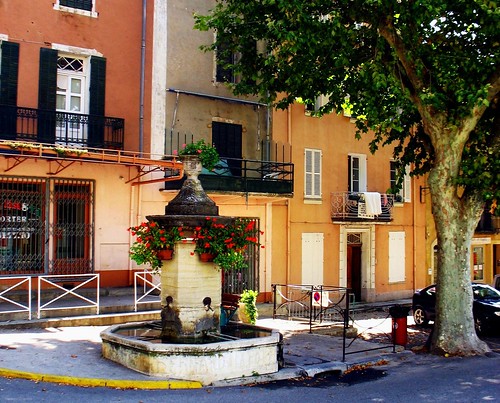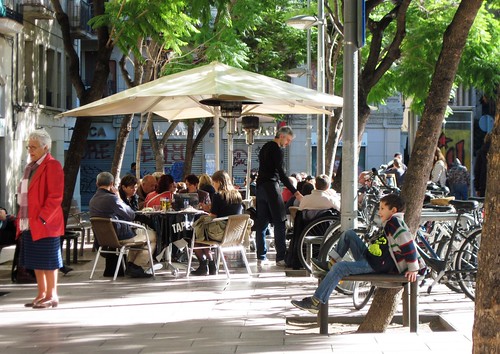There must be a there (excerpted from People Habitat)

Posted May 8, 2013 at 1:26PM
Today’s article is another excerpt from my latest book, People Habitat: 25 Ways to Think about Greener, Healthier Cities. I shared an excerpt from the introduction on March 27.
In the 1930s, Gertrude Stein famously said of Oakland, California, “there is no ‘there’ there.” Was she saying that Oakland had no anchor, no soul, no raison d’etre, no identity? Stein, who was around 60 when she wrote the well-known sentence, had grown up in Oakland, when the city was much smaller. Scholars today insist that she was referring to the loss of places she had known as a child, as in not having a “there” to return to, rather than rendering a general dismissal of the city.
Nonetheless, the phrase has stuck to refer to places that lack character and distinctiveness. (For the record, I do not find the Oakland of today to be one of them.)
We all know such places, unfortunately. In the new suburbs of America, in particular, every place looks like every other place, or so it seems: wide arterial roads, chain retail and scattered office buildings, subdivisions with near-identical houses, a regional shopping mall here and there that looks more or less like all the others, inside and out. If I drive out of Washington on Virginia Route 123, I quite literally do not know where I am for about ten miles. Am I still leaving McLean? Am I in Vienna? Oakton? I forget, which one comes first? Am I approaching Fairfax? The locations may have different names, but not different identities (until you get to the historic core of Fairfax). The truth is that, because of their equivalence, it doesn’t really matter where I am, except as a reference point for how close I am getting to my destination.
In a particularly egregious example cited in his classic 1992 book Edge City, Joel Garreau described a sizable place in New Jersey everyone simply called “287 and 78” (for the intersection of two Interstate highways). It was a community in the geographic sense, but not in character or its political administration. According to Garreau, 287 and 78 had no formal boundaries, no elected ruling structure, and no overall leader. Rather, the place was “governed” by a patchwork of generally uncoordinated and conflicting zoning, planning, and county boards. Unfortunately, many places in America can be described much as Garreau described 287 and 78.
We all also know places that most certainly do have a “there”: when we’re in Paris or New York, for example, there’s little doubt that we are in Paris or New York, because the architecture, landmarks and rhythms of the two great cities tell us so. We also know when we are in downtown Missoula or Asheville; when we’re in Santa Fe, it looks and feels like Santa Fe.
We know neighborhoods with a "there," too: I believe having a clear identity and distinctive character can be just as beneficial to neighborhoods as to the larger cities that surround them. Often this identity is signaled and enhanced by memorable public spaces.
In Washington, for example, a well-known urban neighborhood is called Dupont Circle, because there is an actual place (and wonderful small urban park) called Dupont Circle that anchors the neighborhood. In Southern California, we know we’re in Santa Monica (a city within a city that, to me, feels like a large urban neighborhood) because the Palisades overlooking the Pacific Ocean and beach below remind us, as do the famous pier and pedestrian mall. In London’s Bloomsbury or Barcelona’s Gracia district, the neighborhoods are dotted with public squares that lend them character.
I find that I am almost always thinking about the quality of places. I’ve had the good fortune to work closely with some amazing architects who have taught me by example how to do just that, and who have given me a vocabulary to go with my long-held intuitive sense that places feel better when there is, in fact, a “there.” The built environment alone cannot give a place character, but it can either help or hurt, depending on whether it supports or diminishes what filmmaker Sarah Marder calls “the genius of a place.”
Why does this matter to greener and healthier cities? Because places of appealing character and distinctiveness draw us to them and away from sprawl; as they do, they become more sustainable, in a quite literal sense. Their signature public spaces, such as Washington's Dupont Circle, Boston's Quincy Market or Kansas City’s Country Club Plaza, represent not just great venues for hanging out but also continuity of time, place and identity.
 Even in neighborhoods that have been severely disinvested, great or potentially great public spaces represent hope for renewal. In Cincinnati’s wonderfully named Over-the-Rhine (that story will be in my next book), for example, revitalization is made more feasible today because of certain stellar neighborhood anchors that have lasted, such as Washington Park, the Findlay Market, and the Cincinnati Music Hall. When great public spaces strengthen the prospects for walkable, compact settlement, we can reduce the spread of environmental harm.
Even in neighborhoods that have been severely disinvested, great or potentially great public spaces represent hope for renewal. In Cincinnati’s wonderfully named Over-the-Rhine (that story will be in my next book), for example, revitalization is made more feasible today because of certain stellar neighborhood anchors that have lasted, such as Washington Park, the Findlay Market, and the Cincinnati Music Hall. When great public spaces strengthen the prospects for walkable, compact settlement, we can reduce the spread of environmental harm.
When you come down to it, there is no broad sustainability without individual places that help limit environmental impacts while also nourishing the human spirit. People habitat – comprising neighborhoods, small towns, cities, metropolitan regions – is every bit as important to the environment as natural habitat and wilderness.
Indeed, making human places great should be seen as a key strategy for protecting wilderness. Think about the etymology of the word “attractive”: if we attract people to people places, we can better preserve those wild places where we are “visitors but do not remain,” to paraphrase the 1964 federal Wilderness Act. But key to the attraction is having a “there” to be attracted to.
Related posts:
- The power of "creative placemaking" (January 7, 2013)
- Shaping shared places to improve cities (November 13, 2012)
- Is placemaking a "new environmentalism"? (April 23, 2012)
- Preserving a sense of place in LA's Little Tokyo (April 9, 2012)
- Why I support the DC building height restrictions (November 19, 2012)
Move your cursor over the images for credit information.
Please also visit NRDC’s sustainable communities video channels.


